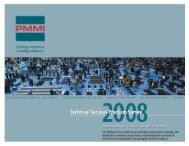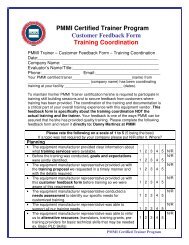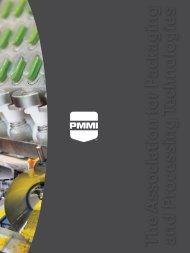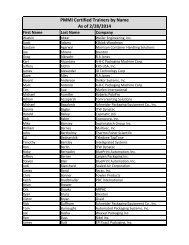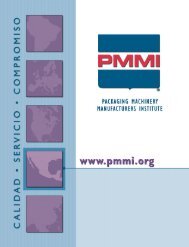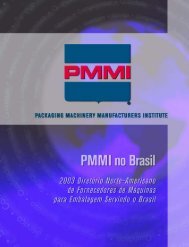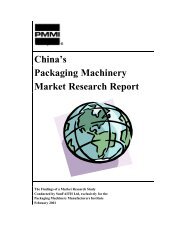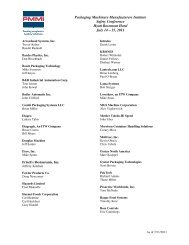Canadian Packaging Machinery Market Research Report - PMMI
Canadian Packaging Machinery Market Research Report - PMMI
Canadian Packaging Machinery Market Research Report - PMMI
You also want an ePaper? Increase the reach of your titles
YUMPU automatically turns print PDFs into web optimized ePapers that Google loves.
or assembly instructions accompanying the equipment must be in both of Canada's<br />
official languages --English and French. Special provincial packaging and labeling<br />
requirements apply in the province of Quebec, and U.S. exporters of non-food FCSL<br />
equipment should contact the Office de la Langue Francaise for more information.<br />
1.7 REGULATORY ISSUES AFFECTING PACKAGING<br />
Heath Canada is responsible for administering the Food and Drugs Act. This Act<br />
applies to all food, drugs, cosmetics and medical devices sold in Canada, whether<br />
manufactured in Canada or imported. The Act and Regulations ensures the safety of<br />
and prevent deception in relation to foods, drugs, cosmetics and medical devices by<br />
governing their sale and advertisement and, in addition, sets out the labeling<br />
requirements for food. A consolidation of the Food and Drugs Act and of the Food<br />
and Drug Regulations issued by the Department of Health can be found at:<br />
http://www.hc-sc.gc.ca/food-aliment/friia-raaii/food_drugs-aliments_drogues/actloi/e_index.html.<br />
Pre-packaged products sold in Canada are subject to mandatory labeling<br />
requirements regarding product identity, product net quantity, and dealer’s name, and<br />
principal place of business, requirements that are described in more detail below.<br />
Some further requirements include:<br />
• The name of a product must appear on the label of pre-packaged consumer<br />
goods in both English and French.<br />
• All mandatory information on food labels must be shown in both French and<br />
English.<br />
• In Quebec, labeling of food products must be in French or have a French version<br />
displayed at least as prominently as the other language.<br />
• Labels of shipping containers (such as those for commercial, industrial or<br />
institutional use), are not required to be bilingual, but do need a net quantity<br />
declaration in either metric or <strong>Canadian</strong> measure.<br />
• Information shown on labels is subject to minimum type size requirements.<br />
• A wide range of consumer items are now limited to a specific number of standard<br />
metric package sizes. This particularly relates to products such as laundry<br />
detergents, soaps, deodorants, shaving creams, hairsprays, shampoo, perfume,<br />
skin creams and other cosmetic goods.<br />
• Statements of national meat inspection and of plant number must be indicated on<br />
labels or cartons of imported meat.<br />
• Textile articles, food (including meat, fish and eggs), drugs, alcohol and cosmetics<br />
are also subject to more stringent labeling requirements.<br />
In Canada, the existence of bilingualism has significant implications for packaging.<br />
Canada requires bilingual labeling (English and French) for most products. Bilingual<br />
designation of the generic name on most pre-packaged consumer products is<br />
required by the federal Consumer <strong>Packaging</strong> and Labeling Act. Under this Act, the<br />
SMG/Columbia Consulting Group Page 10



